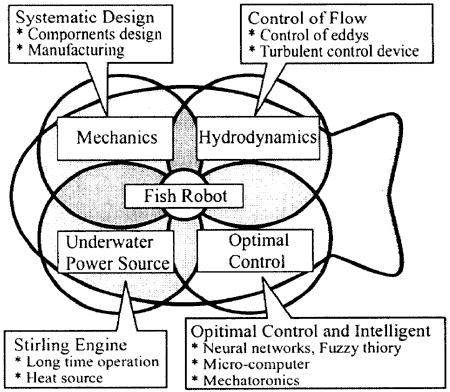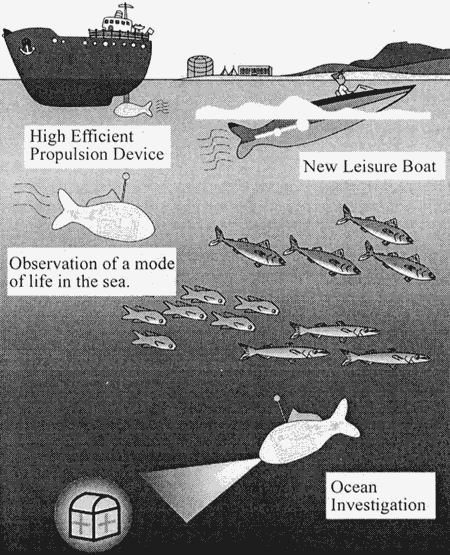4. SUGGESTIONS FOR HIGH PERFORMANCE FISH ROBOT
From the above experiments, fundamental performance of the prototype fish robot is clarified. Also, problems on operation and experiment are clarified. Researches required to get higher performance are described in this chapter.
Figure 9 shows the research subjects needed for the high performance fish robot conceptually. It consists of the fields of mechanics, hydrodynamics, optimal control and underwater power source.

Fig. 9 Subjects needed for high performance fish robot
(1) Mechanics:
In the mechanical field, it is necessary to develop of a systematic design method including link mechanism, material and other components. Also, performance estimation methods of the fish robot including turning and acceleration performance will be discussed in our projects.
(2) Hydrodynamics:
In order to develop the high performance fish robot, it is important to analyze fluid dynamics around a fish robot with computer fluid dynamics (CFD) and flow visualization. Also, it is considered to apply a technology to promote and control eddies by a turbulent control device in the next step.
(3) Optimal Control:
A high quality control method and an information system are necessary for optimal control of a fish robot. In this study, the author has discussed to apply Neural network and Fuzzy theory. Also, it is important to develop the fish robot that is controlled by an onboard microcomputer with high performance sensors for underwater use.
(4) Underwater Power Source
Underwater power source is required not only for high power and high efficiency, but also for high reliability and excellent handling. On the other hand, the power source using fuel of high energy density is suitable for a long time operation. In this study, it has been discussed to apply a special type Stirling engine.
5. CONCLUSION
In this study, the prototype fish robot has been designed, manufactured and experimented. As the results, it is clarified fundamental performance of the fish robot and problems on the operation. The author thinks that the results suggest the possibility of a new and high efficient propulsion device for underwater robots or ships. When a high performance fish robot that can swim skillfully and intellectually is developed, it will be used for the fields of ocean development, ocean investigation and marine environmental protection as shown in Fig.10.

Fig. 10 Fish robots in Future
REFERENCES
[1] Ura, T. and Takagawa, S., "Underwater Robots (in Japanese)", (1994), Seizan-do.
[2] Nagai, M., "Hydrodynamics Learning from Dolphin (in Japanese)", (1998), Ohmsha.
[3] Iwai, T., et al., "Fishes - Illustrated Book of Gakken (in Japanese)", (1998), Gakken.
[4] Hirata. K., "Design and Manufacturing of a Small Fish Robot (in Japanese)". Proc. of Japan Society for Design Engineering, No. 99-Spring (1999), p. 29-32.
[5] Hirata, K. and Warashina, S., "Study on Turning Performance of Experimental Fish Robot (in Japanese)", Proc. of Japan Society for Design Engineering, Tohoku Branch (1999), p.68-71.
BACK CONTENTS NEXT